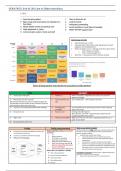Summary
Summary Final year MD notes - geriatrics
- Course
- Institution
A collection suite of final medicine MD notes to ace your penultimate and final year exams! Look no further and save the stress of accessing multiple resources as this PDF collates and summarises information from several resources including but not limited to: -Talley and O’Connor clinical ...
[Show more]



